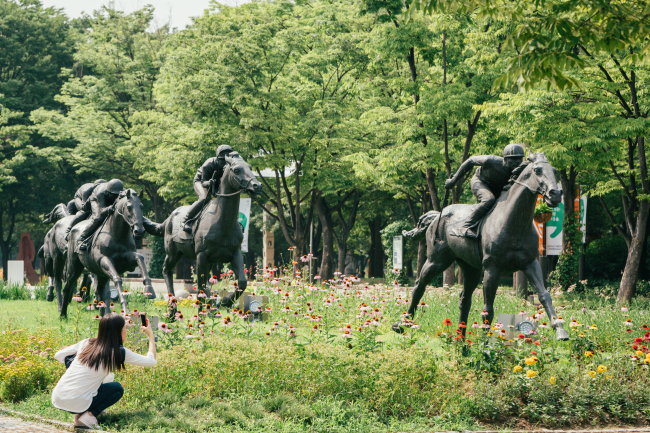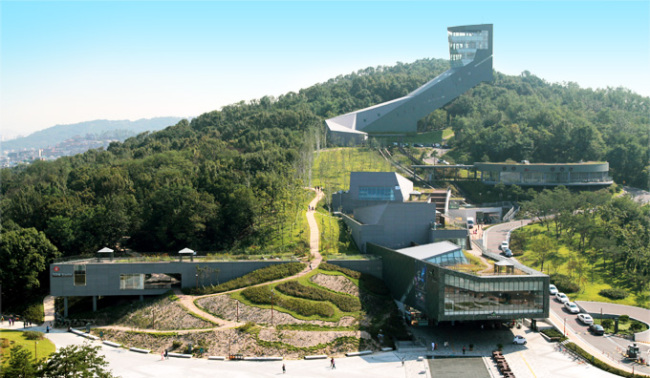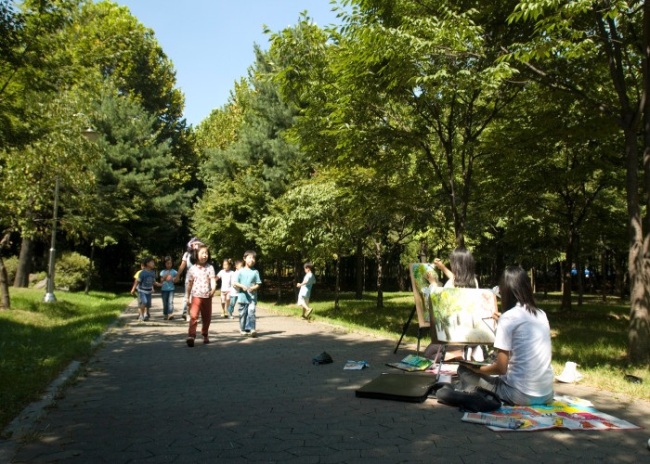As Korea edges towards the crisp, cool weather of fall, more city-dwellers seek the refuge of nature in urban forests. Although not as lush and large as national parks, they are ready to cater to those who crave fresh air and a break from their routine life. Here are the big three city forests in South Korea’s capital.
 |
Statues are seen at forests in Seoul. |
Seoul Forest
Seoul Forest, near Ttukseom Station on Subway Line 2, is on a 595,000-square-meter plot of land that opened in 2005 and is made of five parks, each with different themes.
Parents and children can bond over skating and water activities at the Culture and Arts Park located at the heart of the forest. The Eco Forest is a natural habitat for deer, elks, chipmunks, ducks and many other animals, while the 70,000-square-meter Experimental Learning Park has an insect botanical garden and a wetlands flower garden.
The forest’s observatory deck stands high above ground, waiting for visitors seeking an aerial view of the autumn foliage. After sunset, the deck boasts a view of Seoul’s nighttime city-lights gleaming next to a sea of trees.
The forest is next to the Han River, where visitors can enjoy a fall picnic on the grassy river banks.
Admission is free and wheelchair rental services are available at the visitor’s center in the Culture and Arts Park.
 |
An aerial view of the Dream Forest’s observatory deck. Seoul |
Dream Forest
Once an amusement park, the Seoul Metropolitan Government transformed this northern Seoul area into a woodland in 2009.
Parents and children can interact with deer at a petting zoo, which is by far the forest’s most popular attraction.
The observatory deck within the park is famous as a location for an episode of a 2009 Korean drama series Iris, starring pan-Asian stars Lee Byung-hun and Kim Tae-hee.
The glass elevator that carries viewers up to the deck moves diagonally, offering viewers a unique journey along the way.
The art gallery nearby offers a rest stop with a cultural edge.
The forest is one of the most eco-friendly areas in Korea, with solar panels and a rainwater harvesting system.
It can be reached through a brief taxi ride after getting off at Miasageori Station via Subway Line 4 or Dolgoji Station via Subway Line 6.
 |
Seoulites enjoy activities at Yangjae Citizens’ Forest. Seoul |
Yangjae Citizens’ Forest Yangjae Citizens’ Forest located near Yangjae Tollgate is the largest man-made forest in Seoul. It was created in 1986 to celebrate the Seoul Asian Games that year and the Olympic Games two years later. The forest is a popular spot for dates.
It has an outdoor wedding venue, a walking trail where visitors can walk barefoot in the forest and blend into the surrounding nature, and a statue and memorial hall for Yun Bong-gil, a Korean pro-independence activist during the 1910-1945 Japanese colonial rule.
A barbecue area is available from March to November. There are six outdoor tables equipped with grills, and reservation can be made via the forest’s official website or phone.
The forest is within walking distance of the Shinbundang line Yangjae Citizen’s Forest Station.
By Jung Min-kyung (
mkjung@heraldcorp.com)










